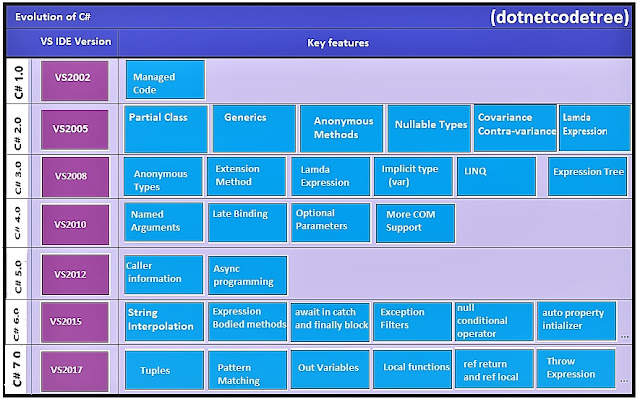C# 7 Features
In this blog post we will discuss about the Local functions/methods, Ref returns and locals,Expression bodied members,Throw Exception from Expression
Local Methods/Functions
Now we can define local functions inside another.Ya, That's right, C# 7 version
provides the ability to call a function which is defined inside another function.
static void Main(string[] args)
{
int localvar = 50;
//local function defined inside main method
int LocalFunction(int a)
{
return localvar * a;
}
Console.WriteLine(LocalFunction(50));
}
If we observe the code above, local function with the name "LocalFunction" is defined
inside the main method and called by main method itself. This is how we can define
a local function to perform a specific operation and return value to the enclosed
function (main function in the above case).
Ref returns and locals
As we already know that C# allows to pass variable by reference by using a ref modifier,
now we can return value by reference type too.
public ref int Search(int element, int[] elements)
{
for (int i = 0; i < elements .Length; i++)
{
if ( elements [i] == element )
{
return ref elements[i]; // return the storage location, not the value
}
}
throw new IndexOutOfRangeException($"{nameof(element)} not found");
}
int[] array = { 12,15,-1,0,10,25,45,23};
ref int place = ref Search(10, array); // aliases 10's place in the array
place = 9; // replaces 10 with 9 in the array
Console.WriteLine(array[4]); // prints 9
Following are the points to note while return value by ref
We can only return refs that are "safe to return": Ones that were passed to you, and ones that point into fields in objects.
Ref locals are initialized to a certain storage location, and cannot be mutated to point to another.
Expression bodied members
Expression bodied members introduced in c# 6.0 version with methods and properties and expanded in C# 7.0 on constructors, destructors, getters & setters. The main purpose is to simplify the syntactical expression
Let’s look at the example to understand how they can be used.
member => expression;
Some of the characteristics of expression bodied members are given below.
They provide clean and clear syntax.
Expression bodied member must have a name, return type and returned expression.
Support for expression body definitions was introduced for methods and property get accessors in C# 6 and was expanded in C# 7.
Expression body definitions can be used with the type members listed in the following table:
| Member | Support as of.. |
| Method | C# 6.0 |
| Constructor | C# 7.0 |
| Finalizer | C# 7.0 |
| Property Get | C# 6.0 |
| Property Set | C# 7.0 |
| Indexer | C# 7.0 |
public Customer(string name) => names.TryAdd(id, name); // constructors
~Person() => names.TryRemove(id, out _);
public string Name
{
get => names[id]; // getters
set => names[id] = value; // setters
}
Throw Exception from Expression
We can easily throw a custom exception in the middle of the expression.
Just call a method which does this.but c# 7 allows throw as an expression
in certain places.
Look at the below code to understand the concept.
class Customer
{
public string Name { get; }
public Customer(string name) => Name = name ?? throw new ArgumentNullException(nameof(name));
public string GetFirstName()
{
var parts = Name.Split(" ");
return (parts.Length > 0) ? parts[0] : throw new InvalidOperationException("No name!");
}
public string GetLastName() => throw new NotImplementedException();
}Thanks
Dotnetcodetree




Comments
Post a Comment